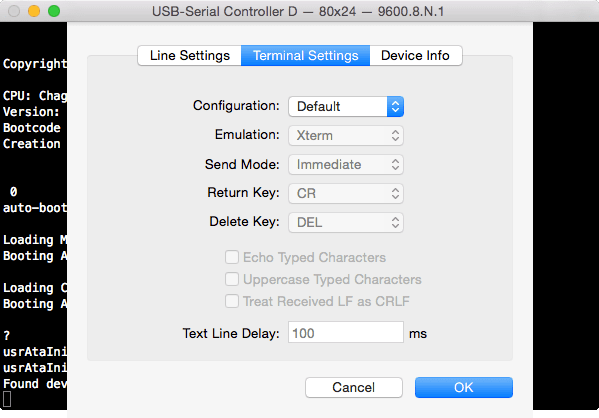OS X Serial Port Apps
Having installed the right driver for our USB-serial adapter, we also need to install some terminal emulation software before we can connect to anything. The following Mac OS X GUI applications are available:
If you're looking for a command line app, there's Screen (built-in) or Minicom.
If you can't find a driver for your adapter (eg, Belkin), try Serial which has built-in support for most (if not all) USB-Serial adapters.
If you have trouble installing any of the following (or any other program) with an unidentified developer error, goto: System Preferences ➤ Secrity & Privacy ➤ General and click on Allow Applications Downloaded from: Anywhere and try again. Or, ctrl-click/right-click on the app and select Open from the pop-up menu so not to permanently lower your security settings...
Serial
Serial is a great Terminal Emulation Program with built-in driver support for most USB to serial devices. If you can't find an OS X driver for your adapter (eg, Belkin), give Serial a try as it'll probably work! The free demo is fully functional for 7 days.Other features include full ANSI/VT100 terminal emulation, break-sequence support (for Cisco, etc), a line-buffered send mode, a fully featured SSH/Telent client, and much more. AND it doesn't crash if you prematurely unplug the adapter! Serial is highly recommended!
ZTerm
To configure ZTerm, open Settings ➤ Modem Preferences and select your USB-Serial device as the default modem (Serial Port). Then edit your connection in Settings ➤ Connection. Remember to connect the USB-Serial cable before launching ZTerm. The following pictures explain the steps:


goSerial
goSerial can open multiple connections simultaneously, send and receive files, log sessions, and it supports scripting. There is no terminal emulation (eg, VT100) support. goSerial is Donation ware.To configure goSerial, click the light switch in the Toolbar and select your USB-Serial device as the Serial Port. The communication settings are set in the same window. The serial ports dynamically updates if devices are added or removed. The following picture shows the settings window:
CoolTerm
CoolTerm is a simple serial port terminal application (again, there's no terminal emulation) that is geared towards hobbyists and professionals with a need to exchange data with hardware connected to serial ports. CoolTerm is Freeware.Features include ability to send and receive data in text or hexadecimal format, multiple concurrent connections (if serial ports are available), local echo, hardware (CTS, DTR) and software flow control (XON), logging of received data to text files, and more.







